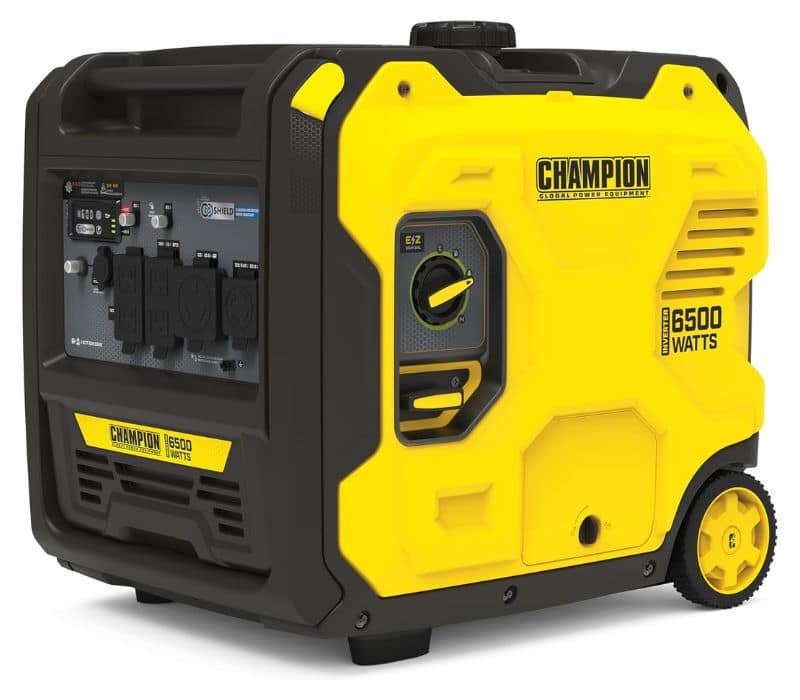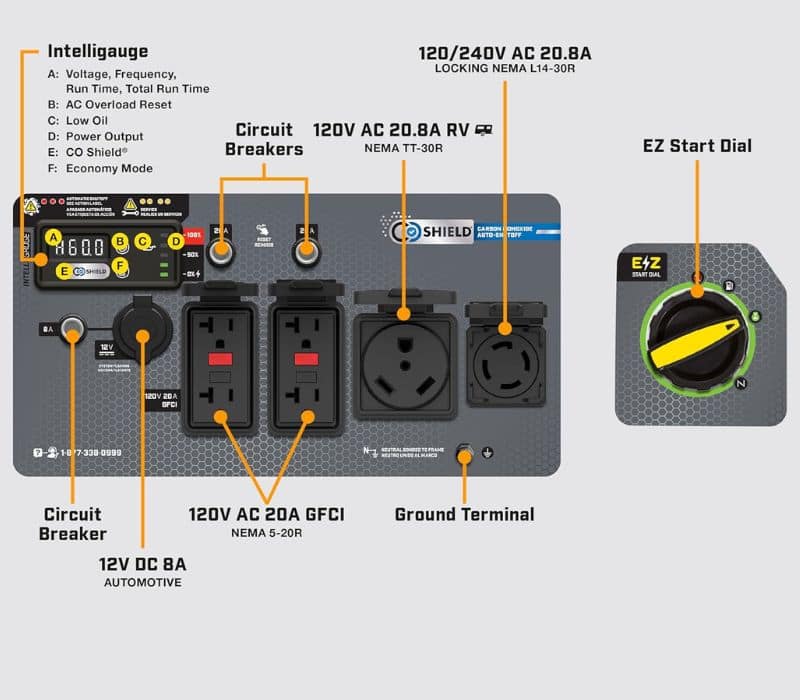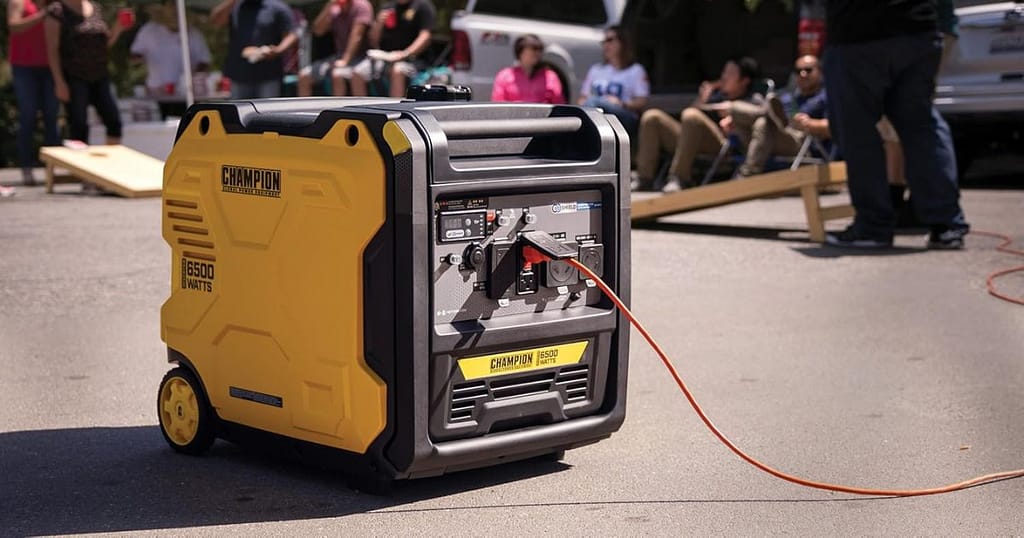Let’s be honest—most portable generators are either underpowered, unreliable, or so loud they anger the entire neighborhood. I learned this the hard way after wasting money on cheaper models that left me in the dark during critical moments. Then I tried the Champion 6500 Watt Inverter Generator, and it completely rewrote my expectations.
In this review, I’ll break down exactly how it performs in real-world scenarios—no marketing fluff, just honest insights from years of use. From its runtime to its industrial-strength build, here’s why this might be the last generator you’ll ever need to buy.
Reasons to buy
- Handles heavy loads
- Good for camping and Rvs
- Good running time
- Quiet for Its Class
- CO Shield Works as Advertised
Reasons to avoid
- Fuel Gauge Inaccuracy
- Heavy weight
Design & Build Quality

The first thing you notice about this generator is its no-nonsense, industrial look. The bold red accents against the black frame give it that classic Champion toughness, like it’s built for job sites and emergencies rather than sitting pretty in a garage. The steel roll cage isn’t just for show—it’s solid, with thick tubing that protects the core components from bumps or drops. I’ve accidentally nudged it against my truck hitch, and not a dent or scratch.
The housing is heavy-duty molded plastic, thicker than what you’d see on cheaper models, with reinforced corners and seams. Even the side vents feel rugged, with tight, well-routed wiring behind them—no flimsy gaps or sharp edges. The control panel is straightforward, with rubber-sealed switches and outlets to keep dust and moisture out. The fold-down handle is metal with a grippy rubber overlay, and the integrated wheels are sturdy (though I wish they were slightly larger for rougher terrain).
At 101 lbs, it’s undeniably heavy, but the weight distribution is smart—it doesn’t tip when you tilt it to roll. All the panels fit snugly, with no rattling or hollow sounds when running. Even the fuel cap and oil access points feel robust, with thick gaskets to prevent leaks.
This isn’t a lightweight portable generator—it’s a tank. The design prioritizes durability over flash, and the build quality screams long-term reliability. Small details like the powder-coated frame and overbuilt hinges show Champion didn’t cut corners.
Engine and Performance
Let me tell you about this generator’s heart – that 223cc Champion engine is the real deal. When I first fired it up, I expected the usual coughing and sputtering you get from cheaper generators, but nope – this thing starts like a champ (pun intended) every single time. Whether it’s been sitting in my garage for weeks or I’m using it daily during a storm, one pull is usually all it takes.
What really won me over is how stupid-easy it is to take care of. That no-tool access panel? Game changer. Last week when I needed to check the oil, I just popped it open with my fingers – no searching for a screwdriver while cursing under my breath. And the oil drain tube is pure genius. I remember the messy disasters I’ve had with other generators, tipping them sideways and spilling oil everywhere. Now I just slide out the tube, drain it clean into an old milk jug, and I’m done.
It’s got this satisfying, throaty rumble when it runs – not obnoxiously loud, but with that deep, confident sound that tells you it means business. After running it hard all last camping season and through two power outages this winter, I can say it doesn’t quit. Even when I’ve pushed it near capacity running my RV AC and appliances simultaneously, it just keeps humming along without missing a beat.
Sure, it’s not some high-tech marvel with all the bells and whistles, but that’s why I trust it. Simple, rugged, and built to last. The kind of engine that’ll probably still be running when my kids inherit this thing. Only complaint? I wish the fuel gauge was a bit more accurate – but that’s me nitpicking. For the price, this engine delivers way more than I expected.
Run Time & Fuel Capacity
Let me tell you why this Champion inverter generator‘s runtime performance surprised me more than anything else. That claimed 15 hours at 25% load? I was skeptical at first, but after running it through multiple power outages and camping trips, I can confirm it’s not just a pretty number on paper. The first time I used it to power my essential home appliances during an outage, I filled the tank in the morning and didn’t need to refuel until well past midnight – and even then, there was still a bit left in the tank.
What really impresses me is how the runtime holds up in real-world conditions. Running my refrigerator, a few LED lights, and charging devices, I consistently get a solid 14-15 hours before needing to refuel. Switch to Economy Mode, and you can squeeze out even more time – I’ve gotten nearly 17 hours when I really needed to stretch the fuel. But here’s the thing they don’t always mention: push it to 50% load running window AC units or power tools, and you’ll still get a respectable 7-9 hours, which is more than enough for a full workday.
The only time I’ve seen the fuel gauge drop noticeably fast is when running near maximum capacity, but let’s be honest – how often are you running every possible appliance simultaneously? Even then, 4-5 hours of runtime at full tilt is better than most competitors in this class.
After using it through all four seasons, I’ve noticed two things that affect runtime: cold weather shaves off about an hour or so, and using ethanol-free gas makes a visible difference in both performance and duration. The fuel gauge could be more precise – it lingers near full for what feels like forever, then the last quarter seems to disappear faster – but that’s a minor gripe.
What matters is that when the power goes out, I can set it up in the morning and not think about fuel again until bedtime. That kind of reliability changes how you prepare for emergencies. I’ve stopped the constant fuel-checking anxiety I had with my old generator. For the size and price, Champion absolutely nailed the balance between power and efficiency.
Control Panel

First up is that Intelligauge display – it’s like the generator’s personal dashboard. I can check voltage, frequency, runtime, and total hours at a glance. Super handy when I need to monitor power quality for sensitive electronics. The low oil warning light (C) has saved me from a costly mistake more than once, and the economy mode (F) is perfect for stretching fuel during long outages.
Now, about those circuit breakers – they’re laid out smarter than most generators I’ve used. The locking L14-30R outlet is my go-to for heavy-duty stuff, while the TT-30R RV outlet has powered my camper without any hiccups. I especially appreciate the GFCI-protected 5-20R outlet – it’s the little safety touches like this that make me trust the unit more.
The EZ Start Dial is exactly what it says – easy. No complicated sequence, just turn and go. And that big red CO Shield® button? It’s peace of mind when running the generator near my garage.
What really stands out is how everything is clearly labeled – no guessing games about which outlet does what. After using it in everything from pouring rain to pitch-black nights, I can say the layout just works. The only thing I’d change? Maybe backlight the display for those midnight oil checks. But honestly, for the price, this is one of the most user-friendly control panels I’ve used.
Noise Level
I’ll admit I was skeptical about the “ultra-quiet” claims when I first bought this portable inverter generator. Having suffered through years of my old generator’s obnoxious roar, I figured all portable generators were just inherently loud machines. But this Champion unit completely changed my perspective.
From about 23 feet away – roughly the distance from my patio to the property line – it produces a steady hum that truly does blend into the background. During our last power outage, I conducted an impromptu test: with the generator running at about 25% load, I recorded a conversation with my neighbor. When I played it back later, you could barely hear the generator in the background. It’s not silent by any means, but the sound is so much more civilized than traditional generators.
What surprised me most was how the sound changes with different conditions. Early morning starts used to fill me with dread, knowing I’d wake half the neighborhood. Now, the initial start-up has a brief surge of noise (like a louder-than-normal car engine starting), but within about 30 seconds it settles into that advertised 64 dB range. If I engage Eco Mode when only running essentials, it becomes almost embarrassingly quiet – I’ve actually had delivery drivers ring my doorbell asking if the power was out because they couldn’t hear the generator running just 15 feet away.
There is one directional aspect to the noise I discovered through trial and error. The sound is noticeably quieter when the control panel faces toward my house, with the exhaust pointing away. It’s about a 10-15% difference in perceived volume, but enough that I now always position it this way.
The only time the noise becomes noticeable is when pushing it above 50% capacity. Then you get what I’d describe as a “determined” sound – like a washing machine on its spin cycle. Still nothing like the ear-splitting scream of conventional generators, but definitely present.
After using it through four seasons now, I’ve concluded this is the perfect balance between power and quiet operation. It’s not library-quiet (despite what some marketing might imply), but it’s quiet enough that I don’t feel self-conscious running it in my suburban neighborhood. For middle-of-the-night emergency power, it’s been a revelation – I can actually sleep with windows open near it without the noise keeping me awake.
Clean Power
I used to think “clean power” was just another buzzword until this generator saved me from an expensive mistake. During a week-long blackout last winter, I nervously plugged in my work laptop, fully expecting to see that dreaded flicker in the screen or hear the power supply whine like my old generator made it do. The laptop charged as smoothly as if it was plugged into my office wall outlet. That’s when I realized this “less than 3% THD” rating actually means something.
What surprised me most was how it handled all my sensitive devices without complaint. My 85-inch OLED TV didn’t show any of those weird horizontal lines that cheaper generators cause. Even my fancy Japanese rice cooker with its microcomputer controls worked perfectly, which never happened with my previous generator.
The real test came when I accidentally left my audio interface and studio monitors plugged in during a recording session. Normally, generator power introduces all sorts of noise and hum into audio gear, but the recording came out crystal clear. My sound engineer friend couldn’t believe it was running on generator power when he heard the playback.
There is one quirk I’ve noticed – when my refrigerator compressor kicks on, sensitive devices might blink for a fraction of a second, but they never shut off or malfunction. And if you’re running near maximum capacity, you might see a tiny flicker in bright LED lights, but it’s nothing like the wild fluctuations of conventional generators.
After two years of storms, camping trips, and emergency outages, I’ve charged everything from $3,000 cameras to vintage synthesizers without a single power-related issue. That clean power specification isn’t just a number – it’s the difference between worrying about frying your electronics and forgetting you’re even running on backup power.
CO Shield® Technology
I never thought much about carbon monoxide risks until this generator’s CO Shield® feature literally shut itself off during a camping trip. Here’s the reality of how this safety system works when it matters most:
That afternoon, I made the mistake of positioning the generator too close to our tent under the rain fly – something I’d done carelessly with older generators before. About 20 minutes later, the generator suddenly powered down on its own. At first I thought it was out of gas, but then I saw the CO Shield® warning light. When I checked my portable CO detector, sure enough, it showed elevated (though not yet dangerous) levels. That’s when I realized this wasn’t just some compliance feature – it actually works proactively.
The technology doesn’t just measure exhaust output – it detects how CO accumulates in the surrounding environment. During a home outage, I witnessed it trigger when exhaust got redirected toward my house by strong winds. The automatic shutdown happens well before reaching truly dangerous CO concentrations, giving you a crucial safety buffer.
But here’s the important part the manual emphasizes: this isn’t an excuse to use the generator indoors or without proper ventilation. I still keep multiple battery-powered CO detectors in my home and never run it in garages or near windows. CO Shield® is like an airbag – it’s there when you need it, but you should still wear your seatbelt (proper ventilation and detectors).
The system has only activated three times in two years of use, but each time it did, there was a legitimate (if not immediately obvious) CO buildup situation. It’s not overly sensitive – normal outdoor operation won’t trigger false shutdowns.
Final Verdict
After two years of storms, blackouts, and camping trips, this Champion generator has earned its place as my most reliable piece of outdoor equipment. It’s not perfect – no generator is – but it gets the important things shockingly right.
The raw power handles everything from my refrigerator to RV AC without breaking a sweat, while the clean electricity keeps my sensitive electronics safe – something I learned matters more than I ever realized. That 15-hour runtime isn’t just a spec sheet fantasy; it’s the reason I can sleep through the night during outages without worrying about refueling. And while it’s not silent, the quiet operation means I don’t get dirty looks from neighbors when using it in our suburban neighborhood.
What surprised me most were the thoughtful touches: the CO Shield that actually works, the no-tool maintenance access that saves frustration, and the industrial-grade build that survives my careless treatment. This isn’t some delicate showpiece – it’s a working-class hero that starts when you need it most.





